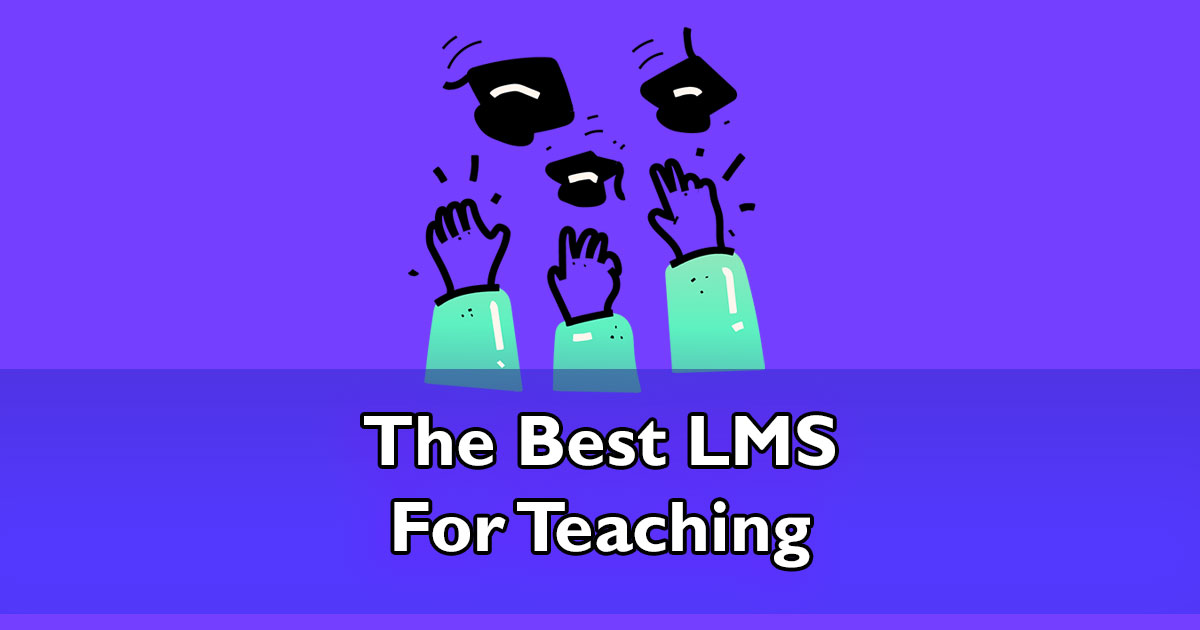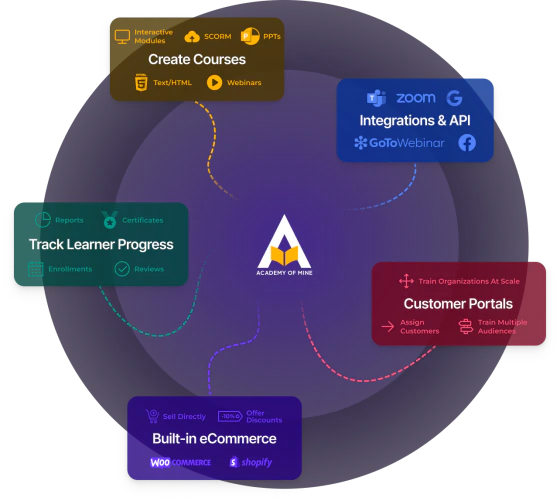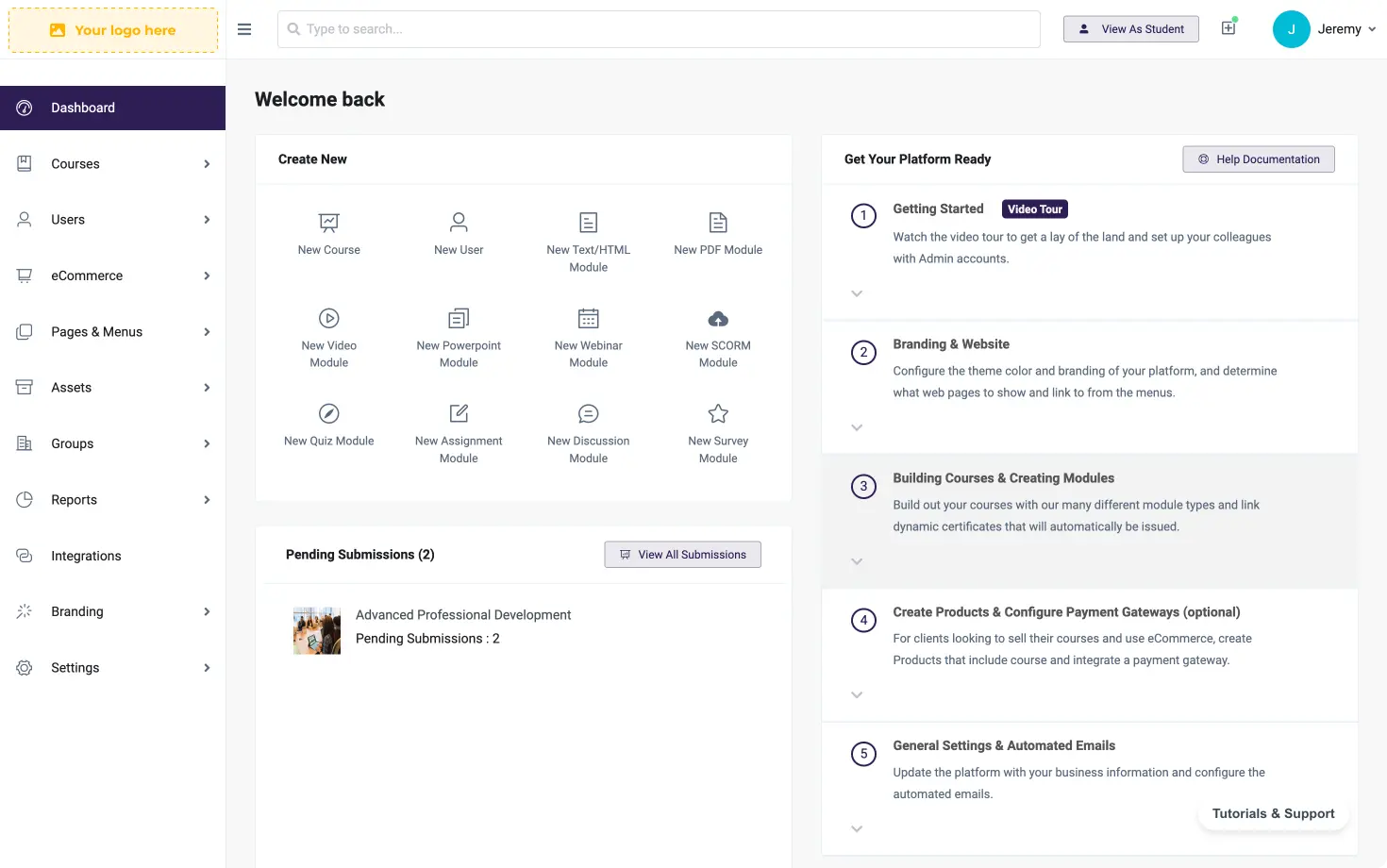eLearning, eLearning As A Business, Learning Management System, Professional Training
Best LMS For Teaching Courses Online

If you’re thinking about offering a self-hosted online course then you’ll undoubtedly come across the need for some type of Learning Management System (LMS). An LMS is a software platform that allows you to effectively administer training online. LMSs help employees, students, and customers learn online using courses and webinars. Using an LMS, your company can improve the different processes involved in managing courses online, including student registration, tracking grades, creating assignments and assessments, restricting students from skipping ahead, and more.
LMSs are the platform that online courses are built upon. Before investing in an LMS, it’s important that your company researches the different platforms available, and is clear on what courses you will be managing, along with the business model being used for selling courses; understanding what features you’re looking for in an LMS is pivotal to your success, especially since every platform is different. Lucky for you, in this article we’re going to discuss the 13 best LMSs for teaching courses online!
1. Academy Of Mine (AOM)
While not a free option, the value AOM offers with its SaaS LMS far surpasses the other free platforms. Many of the free LMSs don’t let you sell your courses, so you can offer your course online, but you can’t make money from them. With Academy Of Mine, you can easily connect with your own eCommerce site, or sell courses directly from the LMS to monetize your eLearning while keeping 100% of the revenue. Secondly, a lot of the free LMSs have a primitive user interface, and don’t let you customize much of the platform’s design; if you’re looking for an LMS that’s customizable and easy to use for both administrators and users enrolled in training, Academy Of Mine is a great choice.
Another feature AOM offers that makes us a great choice for teaching courses online is called groups; groups are essentially isolated training portals that you create for different groups of customers to train. Moreover, If you were selling professional development or k-12 education to customers in different states, you could create a group for each state.
Although AOM is not a free LMS, when you’re selling courses online, our services pay for your monthly fee many times over. Currently, we have multiple customers generating 6 figures monthly from course sales. Right now we’re just comparing LMSs for teaching courses online, but we firmly believe Academy Of Mine is a better alternative LMS to Moodle, Thinkific, and LearnDash for professional training as well!
2. Moodle
Moodle is a free open-source LMS for educators and is one of the most popular free LMSs on the market. It’s open-source, so instead of purchasing a platform that’s easy to use, you’re essentially purchasing code that has to be customized by developers. Even though Moodle’s upfront cost is free, since you will need to hire third parties to help you customize the platform, host the LMS, and update plugins, using Moodle to achieve your education needs is more expensive than a platform like Academy Of Mine.
3. LRN
This ethics and compliance LMS was originally developed at MIT. LRN is used worldwide by over half a million users in higher education, government, non-profit, and K-12. LRN comes out of the box with a lot of great teaching tools like forums, assessments, calendars, grading & reporting, evaluations, surveys, a syllabus, and more. LRN mainly focuses on compliance training for these industries: Manufacturing, Retail and Commerce, Financial Services, Healthcare, and Technology.
4. eFront
eFront is an open source LMS that stopped being developed in 2015, they now offer a SaaS LMS that costs between $1,000 – $2,500+ per month. One advantage of using eFront’s SaaS LMS is their content library, which gives you access to 450+ ready-made courses.
To learn more about SaaS LMSs versus self-hosted open source platforms here’s an article that explains that.
5. Dokeos
Dokeos is an open-source LMS that has pre-built quiz templates and course authoring tools. This PHP-based LMS is designed for compliance training and eLearning, and the industry sectors they focus on are Life Sciences, Training Centers, Healthcare, Retail, Education, and Manufacturing.
6. Sakai
Another open-source LMS option is Sakai. As is stated on Sakai’s website “Each day community members share thousands of interactions – building and improving the software, requesting help, collaborating on projects, and enjoying the relationships that result from this work”. Some of the basic features Sakai offers are course management, grading and assessment tools, integrations with external apps, and more.
7. ATutor
Like many of the other LMSs we’re talking about in this article, ATutor is open-source. At Atutor, you can download a demo from them for 24 hours to try out their platform. For a free platform, ATutor has a lot of great features like course gamification and the support of SCORM 1.2. Additionally, since ATutor is open source, it’s constantly being improved and updated.
8. Blackboard Course Sites
Blackboard is a big name in online education. Many universities, corporate organizations, and government agencies use their main educational LMS called “Blackboard Learn”. However, Blackboard Course Sites is a free LMS of theirs for individual teachers and academics. Since Blackboard Course Sites is a free platform, you are only allowed to upload 500MB of data, and you can only add 5 courses. Similar to the majority of open-source LMSs available, the user interface that Blackboard Course Sites provides looks dated and functions primitively. If you want to provide an excellent user experience to your students enrolled in courses – we recommend using a SaaS LMS, like the Academy Of Mine platform.
9. Latitude Learning
Latitude Learning is a feature-rich “freemium” LMS that’s free to use for up to 100 users. This is a great option for individual professors teaching small classrooms. If you want to go beyond 100 users, Latitude Learning charges you around $2 – $4 per active user. In addition to the cost of active users, Latitude Learning sells a few premium add-ons for their LMS, like the virtual classroom which costs $825/year or $83/month.
10. Schoology
Schoology is another “freemium” LMS option with some great features for both individual teachers and enterprises. Schoology comes with an online grade book, student attendance monitoring, groups, and a student activity tracker. However, if you’re looking to train at scale and you don’t have a team of developers prepared to work on the LMS, fully managed platforms like Academy Of Mine, Thinkific, and LearnDash would be better for you.
11. ILIAS
ILIAS is a SCORM-certified open source Learning Management System. ILIAS is a multipurpose tool that can be used as a flexible course player, an authoring tool, and also as a communication platform. We included ILIAS in this article because they have been around since 1998 and their platform is good for higher education and schools. Unfortunately, like any other open-source LMS, software issues will be your responsibility to fix since tech support is not guaranteed using ILIAS.
12. Udemy
Though Udemy is not an LMS, it’s worth including in this list due to their popularity as a platform for course creators to sell their courses. When an Udemy instructor sells a course using their referral link or coupon code, they keep 97% of the revenue. Alternatively, if a sale is made without using the instructor’s link or coupon, the instructor only keeps 37% of the sales revenue. That said, Udemy is a good option if you are an individual instructor that wants to freelance teach online, and you don’t want to market your courses or write code to build up your learning platform.
When it comes to selling courses at scale, Academy Of Mine is a better alternative to Udemy. The best part is, that AOM hosts your LMS and lets you keep 100% of course sales revenue.
13. Open edX
Open EdX is an open-source LMS co-founded by Harvard and MIT. The platform has rich eCommerce features and is designed to support millions of users. The Open edX platform is designed to be used by higher education, enterprises, and government organizations. Open edX allows you to self-host and manage your platform, or have your platform fully managed by one of their many partners. Each of Open-Edxs’ partners has different pricing and LMS features agreements that you will have to abide by if your platform is being managed by one of them.
Which LMS should I use for Teaching Courses Online?
Most of the LMSs talked about in this article are open-source (free upfront cost). However, since open-source LMSs need to be installed, hosted, and customized using code and forums, the expenses add up quickly. More importantly, without an internal tech team, using an open-source LMS to teach courses online has a high risk of failure — especially since most freelancers you hire for the job won’t have LMS development experience. If you want to teach a few courses online as a side hustle, you might do well with Udemy or Teachable.
Alternatively, if you’re looking to provide education and sell courses at scale, we strongly recommend considering a SaaS LMS like Academy Of Mine. The AOM platform simplifies course management and reporting on students’ performances. Even better, you can connect Academy Of Mine with your CRM, webinar tool, payment gateways like Stripe or Braintree by PayPal, and more. Lastly, at AOM, you have 24/7 tech support to help you customize your LMS and successfully sell educational courses online!
Picking the best LMS for your company is a big decision, here’s how to effectively choose an LMS in 4 steps!

